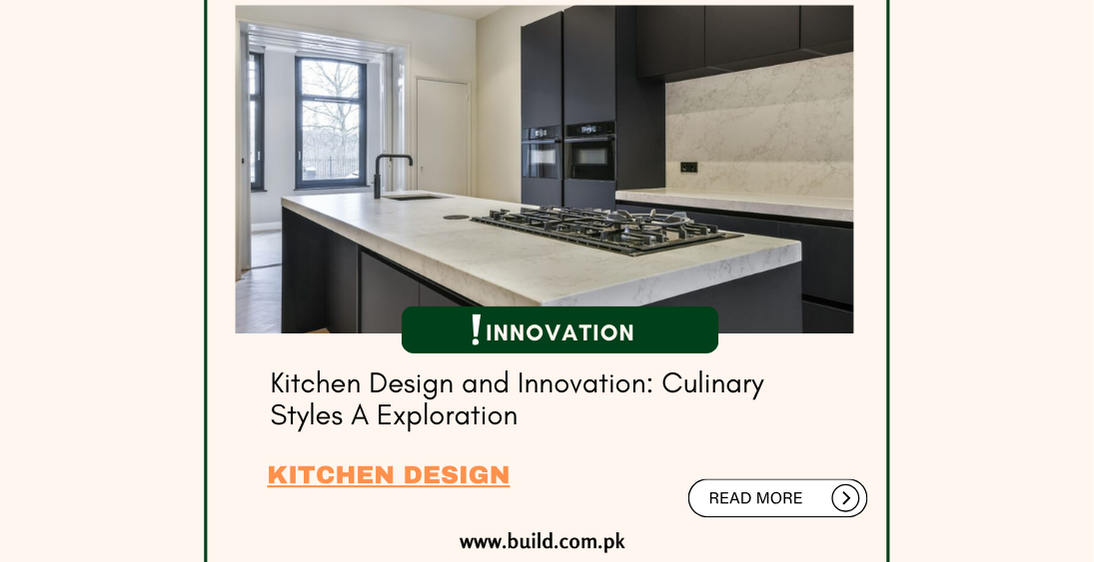Kitchen Design and Innovation: Culinary Styles A Exploration

Introduction:
The kitchen, once confined to a utilitarian space for meal
preparation, has evolved into the heart of the home—a multifaceted hub that
blends functionality, aesthetics, and innovation. In this detailed exploration,
we embark on a journey through the world of kitchen design, unraveling the
historical tapestry, diverse styles, innovative layouts, and transformative
technologies that shape the modern culinary sanctuaries we cherish today.
Historical Evolution:
The roots of kitchen design trace back to ancient
civilizations, where the h mearth served as the focal point for cooking and
communal gathering. Over the centuries, kitchens transitioned from rustic,
utilitarian spaces to more refined areas influenced by cultural shifts and
technological advancements. The 20th century witnessed a dramatic
transformation with the advent of modern appliances and the emergence of the
kitchen as a central living space.
Diverse Styles in Kitchen Design
Traditional Kitchens:
Traditional kitchens draw inspiration from classic design
elements, embracing rich woods, intricate details, and ornate cabinetry. These
kitchens exude a timeless elegance, often incorporating features like farmhouse
sinks and decorative moldings, creating a warm and inviting atmosphere.
Contemporary and Modern Kitchens:
The minimalist ethos of contemporary and modern kitchen
design emphasizes clean lines, open spaces, and a focus on functionality.
Neutral color palettes, high-quality materials, and innovative storage
solutions characterize these kitchens, creating a sleek and sophisticated
ambiance.
Transitional Kitchens:
Transitional kitchens strike a harmonious balance between
traditional and contemporary styles. They blend classic elements with modern
touches, allowing for a seamless transition between different design
aesthetics. Transitional kitchens often feature neutral color schemes,
streamlined cabinetry, and a mix of materials.
Rustic and Farmhouse Kitchens:
Rustic and farmhouse kitchens evoke a sense of nostalgia and
warmth. Exposed beams, reclaimed wood, and vintage-inspired fixtures contribute
to a cozy and charming atmosphere. These kitchens often celebrate the
imperfections of natural materials, creating spaces that feel lived-in and
welcoming.
Innovative Layouts and Spatial Planning
Open-Concept Kitchens:
The open-concept kitchen design has become a popular choice
for modern homes, fostering a sense of connectivity between the kitchen,
dining, and living areas. This layout maximizes space, encourages social
interaction, and allows for seamless transitions between different activities.
Galley Kitchens:
Galley kitchens, characterized by their narrow layout with
parallel c ounters, are designed for efficiency. This layout optimizes workflow
by keeping key areas within easy reach. Galley kitchens are particularly
popular in smaller homes or apartments where space is a premium.
Island and Peninsula Designs:
Kitchen islands and peninsulas serve as versatile focal
points, providing additional workspace, storage, and seating. These designs
enhance functionality, facilitate meal preparation, and often serve as informal
gathering spaces for family and guests.
L-Shaped and U-Shaped Kitchens:
L-shaped and U-shaped kitchen layouts offer customized
configurations to suit different spatial requirements. These designs maximize
counter space and storage, providing a well-organized and efficient cooking
environment.
Innovations in Kitchen Technology
Smart Appliances:
The integration of smart technology into kitchen appliances
has revolutionized the cooking experience. From smart refrigerators with
touchscreens to Wi-Fi-enabled ovens and voice-activated assistants, these
innovations enhance convenience, connectivity, and efficiency in the kitchen.
Energy-Efficient and Sustainable Solutions:
Sustainability has become a central theme in modern kitchen
design. Energy-efficient appliances, eco-friendly materials, and waste
reduction strategies contribute to environmentally conscious kitchens. Recycled
materials, water-saving fixtures, and energy-efficient lighting are integral
components of sustainable kitchen design.
Innovative Storage Solutions:
Modern kitchen design prioritizes innovative storage
solutions to optimize space and reduce clutter. Pull-out pantry shelves,
built-in organizers, and clever use of cabinetry contribute to a well-organized
kitchen that enhances functionality and aesthetics.
Finishes, Materials, and Colors
Cabinet Finishes:
Cabinet finishes play a crucial role in defining the overall
aesthetic of the kitchen. Classic wood finishes, sleek laminates, and
contemporary high-gloss options cater to diverse design preferences. Mixing
finishes or opting for two-tone cabinetry adds visual interest and depth.
Countertop Materials:
The choice of countertop material can significantly impact
the look and functionality of the kitchen. Granite, quartz, marble, and
concrete offer durability and aesthetic versatility. Each material brings a
unique character to the kitchen, c mreating surfaces that are both practical and
visually appealing.
Backsplash Designs:
Backsplash designs have evolved beyond their practical
purpose to become artistic focal points. From classic subway tiles to intricate
mosaic patterns, backsplashes allow for creative expression. The use of bold
colors, textured materials, and patterned tiles adds personality to the
kitchen.
Flooring Options:
Kitchen flooring must withstand high traffic, spills, and
frequent cleaning while complementing the overall design. Tile, hardwood,
laminate, and vinyl are popular choices, each offering a balance between
practicality and aesthetic appeal.
Personalization and Customization:
One of the defining trends in modern kitchen design is the
emphasis on personalization. Homeowners are increasingly seeking custom
solutions that cater to their specific needs and lifestyle. Custom cabinetry,
unique lighting fixtures, and personalized layouts contribute to kitchens that
are as unique as the individuals who inhabit them.
Conclusion:
In the realm of interior design, the kitchen stands as a dynamic and multifaceted space, embodying the essence of creativity, functionality, and innovation. From the timeless elegance of traditional kitchens to the sleek sim mplicity of modern designs, each style brings its own charm to the culinary sanctuary. As we navigate the diverse layouts, materials, and technologies in kitchen design, it becomes evident that the kitchen is not just a place for cooking; it is a canvas for culinary expression and a reflection of the evolving tastes and lifestyles of those who call it home.









